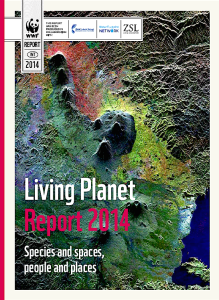Today’s World Animal Day, celebrated across the globe since a 1931 convention of ecologists in Florence, Italy, conceived of it as a way to highlight the plight of endangered species. They chose October 4 because it’s the Catholic Feast Day of St. Francis of Assisi, the patron saint of animals.
Since then, people have used the occasion as an international day of action for animal rights and welfare. It has taken the form of a time to focus on everything from cuddling your pet, to blessing a pack of hounds, to eliminating puppy mills, to addressing hunting (this year’s topic), to recognizing that animals are sentient.
 Here at PlanetSave this year, we’re going back to the original concept of species extinction, mostly because the World Wildlife Fund raised the topic just last week in issuing its biennial Living Planet Report. Briefly, the WWF and its partner agency the Zoological Society of London reported that human demands on nature are 50% higher than those nature can recover from, in terms of groundwater loss, deforestation, carbon dioxide emissions, and other factors.
Here at PlanetSave this year, we’re going back to the original concept of species extinction, mostly because the World Wildlife Fund raised the topic just last week in issuing its biennial Living Planet Report. Briefly, the WWF and its partner agency the Zoological Society of London reported that human demands on nature are 50% higher than those nature can recover from, in terms of groundwater loss, deforestation, carbon dioxide emissions, and other factors.
Mainly, we focus on the report’s uncompromising take on the present and likely future of plant and animal species:
“Population sizes of vertebrate species—mammals, birds, reptiles, amphibians, and fish—have declined by 52 percent over the last 40 years. In other words, those populations around the globe have dropped by more than half in fewer than two human generations.” [By comparison, the human population has almost doubled during this time.]
When the WWF extinction numbers came out on Tuesday, they caused a smaller stir in the media than they should have, some of us think. Today being a worldwide animal holiday, it presents a good opportunity to go over what the WWF has been trying to tell us.
 The WWF compiles a “Living Planet Index” based on trends in 10,380 populations of 3,038 mammal, bird, reptile, amphibian, and fish species. Its report is specific, graphically focused, and well supported by wide research. Among the conclusions:
The WWF compiles a “Living Planet Index” based on trends in 10,380 populations of 3,038 mammal, bird, reptile, amphibian, and fish species. Its report is specific, graphically focused, and well supported by wide research. Among the conclusions:
- The largest declines in vertebrate wildlife were in tropical regions, especially Latin America.
- The most severe decline was among populations of freshwater species, which fell by 76% over the four decades studied.
- Marine and terrestrial species also fell, both by 39%.
- Species populations mainly declined through exploitation from hunting or fishing (37%), habitat alteration and climate change (31.4%), and outright habitat loss (13%).
The report also measured national statistics relating to ecological footprints and biocapacity: how many resources each nation consumes and how many it wastes per person. For once the US is not the world’s worst offender. The WWF extinction report found the most culpable societies to be in Kuwait, Qatar, and the United Arab Emirates. “If all people on the planet had the footprint of the average resident of Qatar, we would need 4.8 planets. If we lived the lifestyle of a typical resident of the USA, we would need 3.9 planets,” the report said. It found that less developed countires like India, Indonesia, and the Democratic Republic of Congo have sustainable ecological footprints.
Finally, the WWF extinction report measured how close we have come to nine “planetary boundaries”— thresholds of potentially catastrophic change to “life as we know it.” We’ve already crossed three lines with lost biodiversity, high carbon dioxide levels, and nitrogen pollution from fertilizers. Two more—ocean acidification and phosphorus levels in fresh water—are nearing their own tipping points. A sober conclusion:
“Given the pace and scale of change, we can no longer exclude the possibility of reaching critical tipping points that could abruptly and irreversibly change living conditions on Earth.”
We’re not just talking 3200 wild tigers any more. Everyone needs to know the causes of extinction and pitch in with individual contributions of time and resources. But WWF believes that “though the report confirms some disturbing trends, we can still change course…. WWF focuses on protecting wildlife, conserving natural capital—from forests and oceans to freshwater and grasslands—and producing and consuming food more wisely. Together with our members and partners, we advocate for change and find solutions that will safeguard our planet and future.”
I am utterly disgusted that many American Tea Party activists have claimed that the mass extinction is a lie made up by liberals. Dead polar bears are not liberals. They are victims of the fossil fuel industry.
We must take care of our planet.